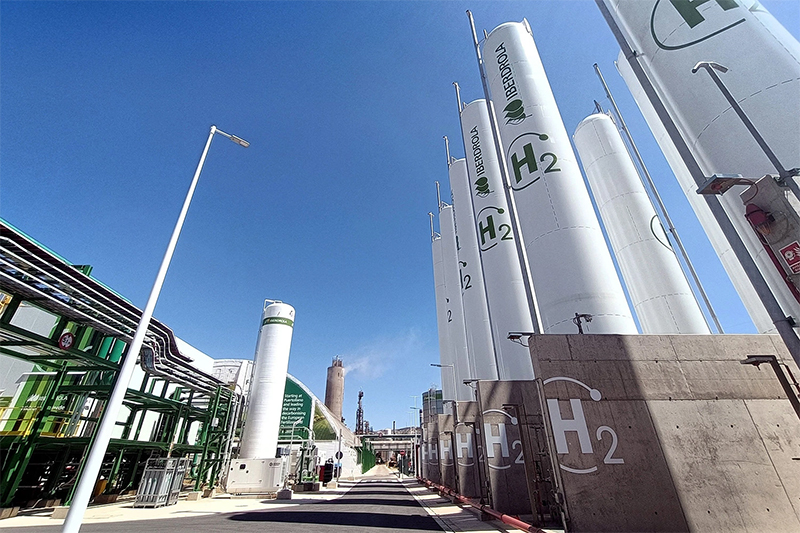|
FB
July
14, 2023
By
Adam
Tooze
Hydrogen Is the Future—or a Complete Mirage
The green-hydrogen
industry is a case study in the potential—for better and worse—of our
new economic era.

An employee of Air Liquide in front of an
electrolyzer at the company's future hydrogen production facility of
renewable hydrogen in Oberhausen, Germany, on May 2. INA FASSBENDER/
AFP VIA GETTY IMAGES
With the vast majority of the world’s governments
committed to decarbonizing their economies in the next two
generations, we are embarked on a voyage into the unknown. What was
once an argument over carbon pricing and emissions trading has turned
into an industrial policy race. Along the way there will be resistance
and denial. There will also be breakthroughs and unexpected wins. The
cost of solar and wind power has fallen spectacularly in the last 20
years. Battery-powered electric vehicles (EVs) have moved from fantasy
to ubiquitous reality.
But alongside outright opposition and clear wins, we will also have to
contend with situations that are murkier, with wishful thinking and
motivated reasoning. As we search for technical solutions to the
puzzle of decarbonization, we must beware the mirages of the energy
transition.
On a desert trek a mirage can be fatal. Walk too far in the wrong
direction, and there may be no way back. You succumb to exhaustion
before you can find real water. On the other hand, if you don’t head
toward what looks like an oasis, you cannot be sure that you will find
another one in time.
Right now, we face a similar dilemma, a dilemma
of huge proportions not with regard to H2O but one of its components,
H2—hydrogen. Is hydrogen a key part of the world’s energy future or a
dangerous fata morgana? It is a question on which tens of trillions of
dollars in investment may end up hinging. And scale matters.
For decades, economists warned of the dangers of trying through
industrial policy to pick winners. The risk is not just that you might
fail, but that in doing so you incur costs. You commit real resources
that foreclose other options. The lesson was once that we should leave
it to the market. But that was a recipe for a less urgent time. The
climate crisis gives us no time. We cannot avoid the challenge of
choosing our energy future. As Chuck Sabel and David Victor argue in
their important new book Fixing the Climate: Strategies for an
Uncertain World, it is through local partnership and experimentation
that we are most likely to find answers to these technical dilemmas.
But, as the case of hydrogen demonstrates, we must beware the efforts
of powerful vested interests to use radical technological visions to
channel us toward what are in fact conservative and ruinously
expensive options.

A green hydrogen plant built by Spanish
company Iberdrola in Puertollano, Spain, on April 18. VALENTIN
BONTEMPS/AFP VIA GETTY IMAGES
In the energy future there are certain elements
that seem clear. Electricity is going to play a much bigger role than
ever before in our energy mix. But some very knotty problems remain.
Can electricity suffice? How do you unleash the chemical reactions
necessary to produce essential building blocks of modern life like
fertilizer and cement without employing hydrocarbons and applying
great heat? To smelt the 1.8 billion tons of steel we use every year,
you need temperatures of almost 2,000 degrees Celsius. Can we get
there without combustion? How do you power aircraft flying thousands
of miles, tens of thousands of feet in the air? How do you propel
giant container ships around the world? Electric motors and batteries
can hardly suffice.
Hydrogen recommends itself as a solution because it burns very hot.
And when it does, it releases only water. We know how to make hydrogen
by running electric current through water. And we know how to generate
electricity cleanly. Green hydrogen thus seems easily within reach.
Alternatively, if hydrogen is manufactured using natural gas rather
than electrolysis, the industrial facilities can be adapted to allow
immediate, at-source CO2 capture. This kind of hydrogen is known as
blue hydrogen.
Following this engineering logic, H2 is presented by its advocates as
a Swiss army knife of the energy transition, a versatile adjunct to
the basic strategy of electrifying everything. The question is whether
H2 solutions, though they may be technically viable, make any sense
from the point of view of the broader strategy of energy transition,
or whether they might in fact be an expensive wrong turn.
Using hydrogen as an energy store is hugely
inefficient. With current technology producing hydrogen from water by
way of electrolysis consumes vastly more energy than will be stored
and ultimately released by burning the hydrogen. Why not use the same
electricity to generate the heat or drive a motor directly? The
necessary electrolysis equipment is expensive. And though hydrogen may
burn cleanly, as a fuel it is inconvenient because of its corrosive
properties, its low energy per unit of volume, and its tendency to
explode. Storing and moving hydrogen around will require huge
investment in shipping facilities, pipelines, filling stations, or
facilities to convert hydrogen into the more stable form of ammonia.
The kind of schemes pushed by hydrogen’s lobbyists foresee annual
consumption rising by 2050 to more than 600 million tons per annum,
compared to 100 million tons today. This would consume a huge share of
green electricity production. In a scenario favored by the Hydrogen
Council, of the United States’ 2,900 gigawatts of renewable energy
production, 650 gigawatts would be consumed by hydrogen electrolysis.
That is almost three times the total capacity of renewable power
installed today.
The costs will be gigantic. The cost for a hydrogen build-out over
coming decades could run into the tens of trillions of dollars. Added
to which, to work as a system, the investment in hydrogen production,
transport, and consumption will have to be undertaken simultaneously.
Little wonder, perhaps, that though the vision of
the “hydrogen economy” as an integrated economic and technical system
has been around for half a century, we have precious little actual
experience with hydrogen fuel. Indeed, there is an entire cottage
industry of hydrogen skeptics. The most vocal of these is Michael
Liebreich, whose consultancy has popularized the so-called hydrogen
ladder, designed to highlight how unrealistic many of them are. If one
follows the Liebreich analysis, the vast majority of proposed hydrogen
uses in transport and industrial heating are, in fact, unrealistic due
to their sheer inefficiency. In each case there is an obvious
alternative, most of them including the direct application of
electricity.

Technicians work on the construction of
a hydrogen bus at a plant in Albi, France, on March 4, 2021. GEORGES
GOBET/AFP VIA GETTY IMAGES
Nevertheless, in the last six years a huge
coalition of national governments and industrial interests has
assembled around the promise of a hydrogen-based economy.
The Hydrogen Council boasts corporate sponsors ranging from Airbus and
Aramco to BMW, Daimler Truck, Honda, Toyota and Hyundai, Siemens,
Shell, and Microsoft. The national governments of Japan, South Korea,
the EU, the U.K., the U.S., and China all have hydrogen strategies.
There are new project announcements regularly. Experimental shipments
of ammonia have docked in Japan. The EU is planning an elaborate
network of pipelines, known as the hydrogen backbone. All told, the
Hydrogen Council counts $320 billion in hydrogen projects announced
around the world.
Given the fact that many new uses of hydrogen are untested, and given
the skepticism among many influential energy economists and engineers,
it is reasonable to ask what motivates this wave of commitments to the
hydrogen vision.
In technological terms, hydrogen may represent a
shimmering image of possibility on a distant horizon, but in political
economy terms, it has a more immediate role. It is a route through
which existing fossil fuel interests can imagine a place for
themselves in the new energy future. The presence of oil majors and
energy companies in the ranks of the Hydrogen Council is not
coincidental. Hydrogen enables natural gas suppliers to imagine that
they can transition their facilities to green fuels. Makers of
combustion engines and gas turbines can conceive of burning hydrogen
instead. Storing hydrogen or ammonia like gas or oil promises a
solution to the issues of intermittency in renewable power generation
and may extend the life of gas turbine power stations. For governments
around the world, a more familiar technology than one largely based on
solar panels, windmills, and batteries is a way of calming nerves
about the transformation they have notionally signed up for.
Looking at several key geographies in which hydrogen projects are
currently being discussed offers a compound psychological portrait of
the common moment of global uncertainty.

A worker at the Fukushima Hydrogen
Energy Research Field, a test facility that produces hydrogen from
renewable energy, in Fukushima, Japan, on Feb. 15. RICHARD A. BROOKS/AFP
VIA GETTY IMAGES
The first country to formulate a national
hydrogen strategy was Japan. Japan has long pioneered exotic energy
solutions. Since undersea pipelines to Japan are impractical, it was
Japanese demand that gave life to the seaborne market for liquefied
natural gas (LNG). What motivated the hydrogen turn in 2017 was a
combination of post-Fukushima shock, perennial anxiety about energy
security, and a long-standing commitment to hydrogen by key Japanese
car manufacturers. Though Toyota, the world’s no. 1 car producer,
pioneered the hybrid in the form of the ubiquitous Prius, it has been
slow to commit to full electric. The same is true for the other East
Asian car producers—Honda, Nissan, and South Korea’s Hyundai. In the
face of fierce competition from cheap Chinese electric vehicles, they
embrace a government commitment to hydrogen, which in the view of many
experts concentrates on precisely the wrong areas i.e. transport and
electricity generation, rather than industrial applications.
The prospect of a substantial East Asian import demand for hydrogen
encourages the economists at the Hydrogen Council to imagine a global
trade in hydrogen that essentially mirrors the existing oil and gas
markets. These have historically centered on flows of hydrocarbons
from key producing regions such as North Africa, the Middle East, and
North America to importers in Europe and Asia. Fracked natural gas
converted into LNG is following this same route. And it seems possible
that hydrogen and ammonia derived from hydrogen may do the same.
CF Industries, the United States’ largest producer of ammonia, has
finalized a deal to ship blue ammonia to Japan’s largest power utility
for use alongside oil and gas in power generation. The CO2 storage
that makes the ammonia blue rather than gray has been contracted
between CF Industries and U.S. oil giant Exxon. A highly defensive
strategy in Japan thus serves to provide a market for a conservative
vision of the energy transition in the United Sates as well.
Meanwhile, Saudi Aramco, by far the world’s largest oil company, is
touting shipments of blue ammonia, which it hopes to deliver to Japan
or East Asia. Though the cost in terms of energy content is the
equivalent of around $250 per barrel of oil, Aramco hopes to ship 11
million tons of blue ammonia to world markets by 2030.
To get through the current gas crisis, EU nations have concluded LNG
deals with both the Gulf states and the United States. Beyond LNG, it
is also fully committed to the hydrogen bandwagon. And again, this
follows a defensive logic. The aim is to use green or blue hydrogen or
ammonia to find a new niche for European heavy industry, which is
otherwise at risk of being entirely knocked out of world markets by
high energy prices and Europe’s carbon levy.
The European steel industry today accounts for less than ten percent
of global production. It is a leader in green innovation. And the
world will need technological first-movers to shake up the fossil-fuel
dependent incumbents, notably in China. But whether this justifies
Europe’s enormous commitment to hydrogen is another question. It seems
motivated more by the desire to hold up the process of
deindustrialization and worries about working-class voters drifting
into the arms of populists, than by a forward looking strategic
calculus.
In the Netherlands, regions that have hitherto served as hubs for
global natural gas trading are now competing for designation as
Europe’s “hydrogen valley.” In June, German Chancellor Olaf Scholz and
Italian Prime Minister Giorgia Meloni inked the contract on the SoutH2
Corridor, a pipeline that will carry H2 up the Italian peninsula to
Austria and southern Germany. Meanwhile, France has pushed Spain into
agreeing to a subsea hydrogen connection rather than a natural gas
pipeline over the Pyrenees. Spain and Portugal have ample LNG terminal
capacity. But Spain’s solar and wind potential also make it Europe’s
natural site for green hydrogen production and a “green hydrogen”
pipe, regardless of its eventual uses, looks in the words of one
commentator looks “less pharaonic and fossil-filled” than the original
natural gas proposal.

A hydrogen-powered train is refilled by a mobile
hydrogen filling station at the Siemens test site in Wegberg, Germany,
on Sept. 9, 2022. BERND/AFP
VIA GETTY IMAGES
How much hydrogen will actually be
produced in Europe remains an open question. Proximity to the point of
consumption and the low capital costs of investment in Europe speak in
favor of local production. But one of the reasons that hydrogen
projects appeal to European strategists is that they offer a new
vision of European-African cooperation. Given demographic trends and
migration pressure, Europe desperately needs to believe that it has a
promising African strategy. Africa’s potential for renewable
electricity generation is spectacular. Germany has recently entered
into a hydrogen partnership with Namibia. But this raises new
questions.
First and foremost, where will a largely desert country source the
water for electrolysis? Secondly, will Namibia export only hydrogen,
ammonia, or some of the industrial products made with the green
inputs? It would be advantageous for Namibia to develop a
heavy-chemicals and iron-smelting industry. But from Germany’s point
of view, that might well defeat the object, which is precisely to
provide affordable green energy with which to keep industrial jobs in
Europe.
A variety of conservative motives thus converge in the hydrogen
coalition. Most explicit of all is the case of post-Brexit Britain.
Once a leader in the exit from coal, enabled by a “dash for gas” and
offshore wind, the U.K. has recently hit an impasse. Hard-to-abate
sectors like household heating, which in the U.K. is heavily dependent
on natural gas, require massive investments in electrification,
notably in heat pumps. These are expensive. In the United Kingdom, the
beleaguered Tory government, which has presided over a decade of
stagnating real incomes, is considering as an alternative the
widespread introduction of hydrogen for domestic heating. Among energy
experts this idea is widely regarded as an impractical boondoggle for
the gas industry that defers the eventual and inevitable
electrification at the expense of prolonged household emissions. But
from the point of view of politics, it has the attraction that it
costs relatively less per household to replace natural gas with
hydrogen.

Employees work on the assembly line of
fuel cell electric vehicles powered by hydrogen at a factory in
Qingdao, Shandong province, China, on March 29, 2022.VCG VIA GETTY
IMAGES
As this brief tour suggests, there is every
reason to fear that tens of billions of dollars in subsidies, vast
amounts of political capital, and precious time are being invested in
“green” energy investments, the main attraction of which is that they
minimize change and perpetuate as far as possible the existing
patterns of the hydrocarbon energy system. This is not greenwashing in
the simple sense of rebadging or mislabeling. If carried through, it
is far more substantial than that. It will build ships and put pipes
in the ground. It will consume huge amounts of desperately scarce
green electricity. And this faces us with a dilemma.
In confronting the challenge of the energy transition, we need a bias
for action. We need to experiment. There is every reason to trust in
learning-curve effects. Electrolyzers, for instance, will get more
affordable, reducing the costs of hydrogen production. At certain
times and in certain places, green power may well become so abundant
that pouring it into electrolysis makes sense. And even if many
hydrogen projects do not succeed, that may be a risk worth taking. We
will likely learn new techniques in the process. In facing the
uncertainties of the energy transition, we need to cultivate a
tolerance for failure. Furthermore, even if hydrogen is a prime
example of corporate log-rolling, we should presumably welcome the
broadening of the green coalition to include powerful fossil fuel
interests.
The real and inescapable tradeoff arises when we commit scarce
resources—both real and political—to the hydrogen dream. The limits of
public tolerance for the costs of the energy transition are already
abundantly apparent, in Asia and Europe as well as in the United
States. Pumping money into subsidies that generate huge economies of
scale and cost reductions is one thing. Wasting money on lame-duck
projects with little prospect of success is quite another. What is at
stake is ultimately the legitimacy of the energy transition as such.
In the end, there is no patented method distinguishing self-serving
hype from real opportunity. There is no alternative but to subject
competing claims to intense public, scientific, and technical
scrutiny. And if the ship has already sailed and subsidies are already
on the table, then retrospective cost-benefit assessment is called
for.
Ideally, the approach should be piecemeal and stepwise, and in this
regard the crucial thing to note about hydrogen is that to regard it
as a futuristic fantasy is itself misguided. We already live in a
hydrogen-based world. Two key sectors of modern industry could not
operate without it. Oil refining relies on hydrogen, as does the
production of fertilizer by the Haber-Bosch process on which we depend
for roughly half of our food production. These two sectors generate
the bulk of the demand for the masses of hydrogen we currently
consume.
We may not need 600 million, 500 million, or even 300 million tons of
green and blue hydrogen by 2050. But we currently use about 100
million, and of that total, barely 1 million is clean. It is around
that core that hydrogen experimentation should be concentrated, in
places where an infrastructure already exists. This is challenging
because transporting hydrogen is expensive, and many of the current
points of use of hydrogen, notably in Europe, are not awash in cheap
green power. But there are two places where the conditions for
experimentation within the existing hydrogen economy seem most
propitious.
Green Play Ammonia™, Yielder® NFuel Energy.
Spokane, Washington. 99212
www.exactrix.com
509 995 1879 cell, Pacific.
Nathan1@greenplayammonia.com
exactrix@exactrix.com
|